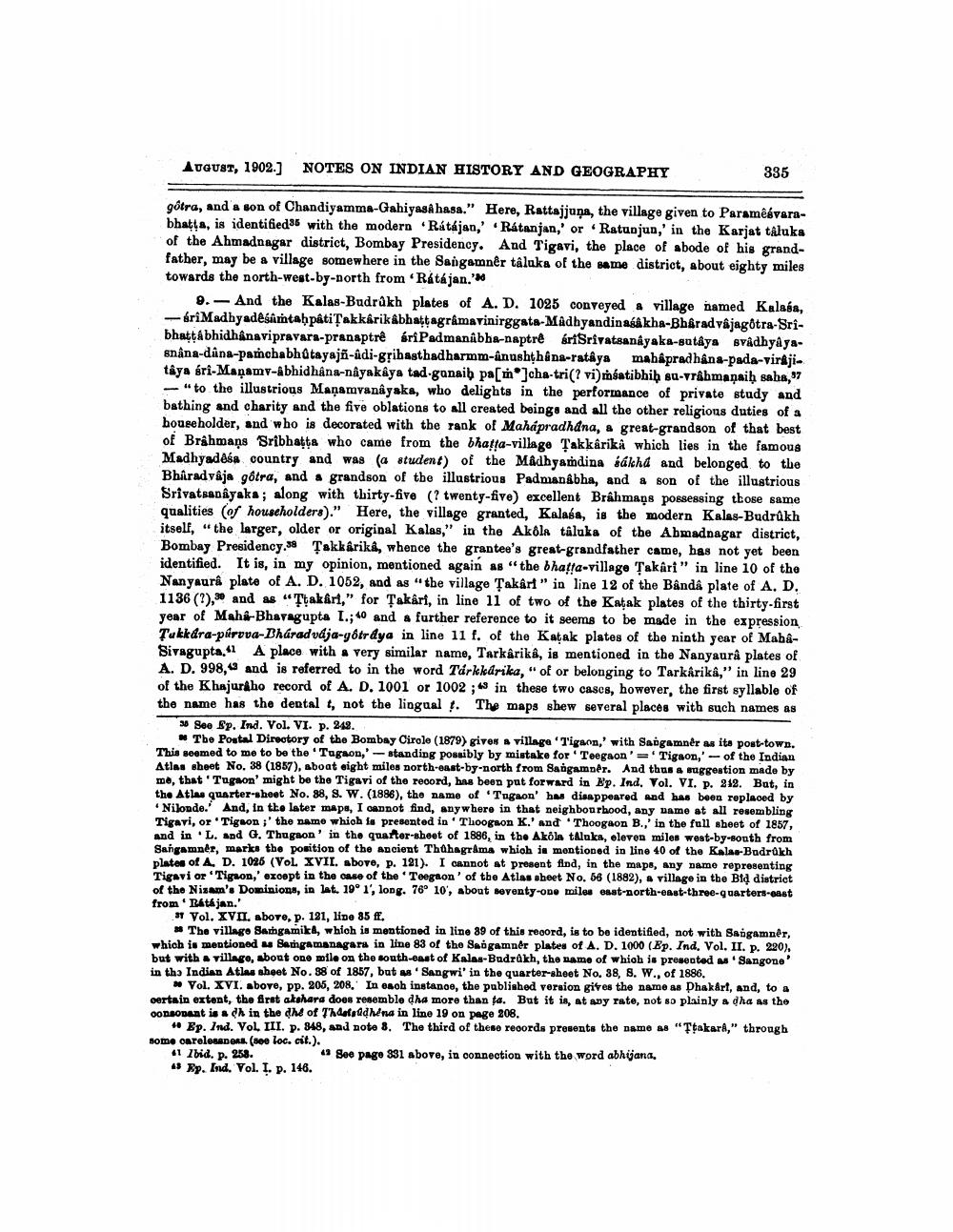________________
August, 1902.) NOTES ON INDIAN HISTORY AND GEOGRAPHY
335
gótra, and a son of Chandiyamma-Gahiyasahasa." Here, Rattajjuna, the village given to Paramêávarabhatta, is identified with the modern Rátájan,' Rátanjan,' or Ratudjun,' in the Karjat taluka of the Ahmadnagar district, Bombay Presidency. And Tigavi, the place of abode of his grandfather, may be a village somewhere in the Sangamner tåluka of the same district, about eighty miles towards the north-west-by-north from Rátájan.'
. And the Kalas-Budråkh plates of A.D. 1025 conveyed a village named Kalasa, - SriMadhyadesimtah pâtisakkarikábhattagramavinirggata-Madhyandinaskha-Bharad vajagðtra-Sribhatt Abhidhanavipravara-pranaptrê éri Padmanabha-naptré sriSrivatsanayaka-satâya svadhyâyasnâna-dana-pamchabhtayaji-adi-gribasthadharmm-anushthina-ratâya mahápradhana-pada-virjitâya sri-Maņamv-abhidhana-nayakaya tad-ganaih pa[m]cha-tri(? vi)méatibhih su-vrâhmanaih saba, 97 -" to the illustrious Maņamvanayaka, who delights in the performance of private study and bathing and charity and the five oblations to all created beings and all the other religious duties of a householder, and who is decorated with the rank of Mahápradhana, a great-grandson of that best of Brahmaņs Sribhatta who came from the bhatta-village Takkârika which lies in the famous Madhyad&a country and was a student) of the Madhyamdina kákha and belonged to the Bharadvaja gôtra, and a grandson of the illustrious Padmanabha, and a son of the illustrious Srivatsanayaka; along with thirty-five (? twenty-five) excellent Brahmaņs possessing those same qualities of householders)." Here, the village granted, Kalaba, is the modern Kalas-Budrukh itself, "the larger, older or original Kalas," in the Akola tâluka of the Abmadnagar district, Bombay Presidency.58 Takkârika, whence the grantee's great-grandfather came, has not yet been identified. It is, in my opinion, mentioned again as "the bhatta-village Takâri" in line 10 of the Nanyaurâ plate of A. D. 1052, and as "the village Takâr " in line 12 of the Bândâ plate of A. D. 1136 (?), * and as "Ttakért," for Takári, in line 11 of two of the Katak plates of the thirty-first year of Maha-Bhavagupta L.; and a further reference to it seems to be made in the expression Tukkdra-púruva-Dháradvája-yotr dya in line 11 f. of the Katak plates of the ninth year of MahaSivagupta. A place with very similar name, Tarkârikê, is mentioned in the Nanyaurâ plates of A. D. 998, and is referred to in the word Tárkkárika," of or belonging to Tarkarika," in line 29 of the Khajuriho record of A.D. 1001 or 1002 ; " in these two cases, however, the first syllable of the name has the dental 1, not the lingual y. The maps shew several places with such names as
30 See Sp. Ind. Vol. VI. p. 249.
# The Postal Directory of the Bombay Cirolo (1879) gives a village 'Tigaon,' with Sangamner as ito post-town. This seemed to me to be the 'Tugaon,'-standing possibly by mistake for Teegaon'=' Tigaon,'- of the Indian Atlas sheet No. 38 (1857), aboat eight miles north-east-by-north from Sangamner. And thus & suggestion made by me, that'Tagaon' might be the Tigari of the record, has been put forward in Ep. Ind. Vol. VI. p. 212. But, in the Atlas quarter-sheet No. 88, 8. W. (1886), the name of Tngaon' has disappeared and has been replaced by • Nilonde. And, in the later Map, I cannot find, anywhere in that neighbourhood, any name at all resembling Tigavi, or Tigaon ;' the name which is presented in 'Thoogaon K.' and 'Thoogaon B.,' in the full sheet of 1857, and in L. and G. Thugaon' in the quarter-sheet of 1886, in the Akon tAluka, eleven miles west-by-south from Sangamner, marks the position of the Ancient Thohagrams which is mentioned in line 40 of the Kalas-Budrukh plates of A. D. 1026 (VOL. XVII. above, p. 121). I cannot at present find, in the mape, any name representing Tigavi or 'Tigron,' zoopt in the case of the 'Toegaon' of the Atlas abeet No. 58 (1882), a village in the Bid district of the Nizam's Dominions, in lat. 19° 1, long. 76° 10', about seventy-one miles east-north-east-three-quarters-east from Ratajan.'
» Vol. XVII, above, p. 191, lide 85 ff.
# The village Sathgamika, whloh is mentioned in line 89 of this record, is to be identified, not with Sangamner, which is mentioned Bathgamanagara in line 83 of the Sangamner plates of A. D. 1000 (Ep. Ind. Vol. II. p. 220), but with villago, about one mile on the southeast of Kalas-Budrakh, the name of whioh is presented as Sangone' in th) Indian Atlas sheet No. 38 of 1857, but m' Sangwi' in the quarter-sheet No. 38, S. W., of 1886.
Vol. XVI. above, pp. 205, 208,' In each instance, the published version gives the name as Dhak Art, and, to a certain extent, the first akshara does resemble dhe more than ta. But it is, at any rate, not so plainly dha as the Consonant issdh in the th of Thdollina in line 19 on page 208.
46 Bp. Ind. VOL. III. p. 848, and noto 8. The third of these records presents the name as "Ttakar," through some oarelosanas (see loc. cit.). 41 Ibid. p. 258.
See page 831 above, in connection with the word abhijana, 15 Ep. Ind. Vol. I. p. 146.




